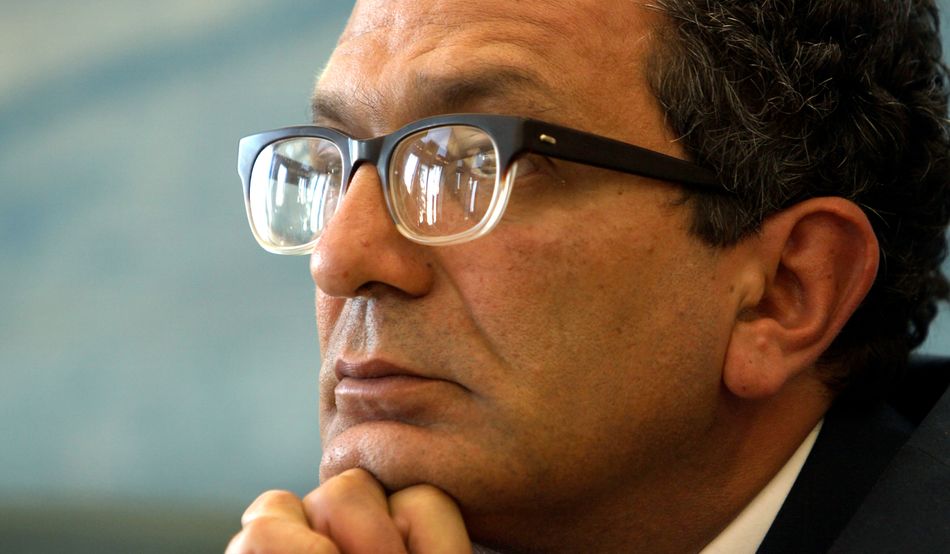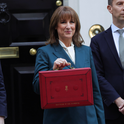If you have turned on the radio, listened to a political podcast or flicked through a newspaper of late, you will have noticed excited chatter about something called Blue Labour.
Its primary spokesperson is the entertaining and highly intelligent Maurice Glasman, a Labour peer. And its ideas are pretty uncompromising: Donald Trump is essentially right, Blue Labour asserts. The working class, betrayed for decades, is leading an insurgent attack on the remaining pillars of the establishment. Muscular nation states are about to replace effete global institutions. Strong borders will put paid to global mobility and multiculturalism. An economy that has been based on finance and social services will be pushed aside for new jobs in factories. Military strength is going to be the first call on the nation’s resources. The task of the government is to build a new home on “the left side of Maga square”.
The ubiquity of these ideas is extraordinary. One day Glasman will be interviewed by Maga hero Steve Bannon, on whose podcast he will compare progressive politics to a life-threatening “palsy”. The next he will be hailed by the Observer as “the man with a hotline to both the White House and Downing St”. Then he will pop up in the Sun suggesting that the UK pursue a military alliance with Ukraine—not just against Russia, but France and Germany too.
Having a unique talent for eye-catching argument does not necessarily gift you with the right answers, though, and especially not in politics. Nor does this kind of ubiquity mean that Blue Labour can provide Keir Starmer’s government with the new narrative it requires.
I should know. I have been very close to the Blue Labour project for years. Since 2010, I have shared many of its ambitions, sat in private dinners and seminars that its originators have hosted, admired its passion, and often argued its case, even against steadfast opponents. But despite all of this I am convinced that the Blue Labour in the headlines now—the Maga-inflected version—is fundamentally misconceived. And if I were ever fortunate enough to advise the prime minister personally, I would urge him to attend to the earlier version—not the one that currently captures all the attention.
Blue Labour’s moment in the political sun has been a long time coming. The original idea of Blue Labour emerged the last time a Labour government limped out of office, 15 years ago. An unlikely group of former Labour big beasts gathered in university seminar rooms to lick their wounds and imagine a way forward. They included the frontline politicians James Purnell, David Lammy, Hazel Blears, Jon Cruddas and David Miliband, alongside advisers such as Graeme Cooke and Andrea Westall, and a few academics, including Maurice Glasman, Jonathan Rutherford, Stuart White and me.
The discussions this group had over a few months gave early shape to Blue Labour and briefly garnered almost as much attention as the movement has now. Those debates were eagerly written up by commentators and journalists. Glasman and others were profiled in the papers (which mattered much more back then). And eventually a host of left-leaning organisations, including Compass, the Fabian Society and the Christian Socialist Movement, agreed jointly to publish an online collection of essays to push the argument on. By the time the resulting ebook—The Labour Tradition and the Politics of Paradox—was published, Ed Miliband had won the Labour leadership election. But rather than his victory marking the end of the project, the younger Miliband wrote a foreword to the collection and elevated Maurice Glasman to the House of Lords.
The initial set of ideas in that book offered a powerful insight into what had gone wrong with the governments of Tony Blair and Gordon Brown. At its heart was an insistence that the “modernising” zeal of their administrations had blinded them to the real value of the past. As Glasman powerfully put it, New Labour had relentlessly told the country that “things can only get better”—but in real life things have a tendency also to get a good deal worse.
This was not mere nostalgia. These Blue Labour conversations were filled with ideas for the future. They emphasised the overlooked importance of the UK’s central institutions—including the monarchy, civil service and the church—in providing a sense of national identity and social stability. They also spoke about the need to build complex coalitions in favour of change, rather than always trying to impose the will of a single social group on everyone else. Blue Labour valued community but it was not “communitarian”, Glasman often insisted, because the movement knew that the common good in a diverse country such as the UK could never be singular. It would always emerge over time, through the careful construction of shared interest across difference.
Blue Labour’s early participants also spoke about the dangers of excessive state power. They discussed the hubristic tendencies of bureaucrats who believe they know best for everyone but grasp little about what actually matters to millions of people. All this was often bundled together into an argument that, over time, New Labour had forgotten the little treasures of everyday life, such as spending time with family, taking an annual holiday, chatting at the school gate, going to church, joining clubs. It had forgotten about the joys of the ordinary. Instead, it had become obsessed with the interests of the rich and famous.
Infused by academics and former academics, Blue Labour’s discussions involved more philosophy than policy. And the philosophy that mattered was sceptical of utopianism, grand visions and the central power of the state. The sources Blue Labour cited included historical figures, such as Aristotle, who was celebrated for the emphasis he placed on experience over abstraction, and Edmund Burke, whose rejection of the grandiose promises of the French Revolution, belief in the power of tradition, and faith in the “little platoons” of everyday English life resonated.
Blue Labour debates also included frequent references to more recent scholars, such as the Irish political scientist Peter Mair, whose Ruling the Void: The Hollowing of Western Democracy, eventually published in 2013, set out how those at the top of political parties live within weird Westminster bubbles, separated from ordinary voters. Another was the American anthropologist, James C Scott, whose brilliant Seeing Like a State (1998) highlighted the absurd arrogance of governing authorities that dismiss the experience and expertise of people on the ground.
The debate wasn’t all intellectual, though. There was a distinctive political voice to early Blue Labour, which was heavily dependent on the practical experience of community organising. In the first decade of this century, the nonpartisan community alliance Citizens UK had brought together a previously unimagined coalition of churches, mosques, synagogues and temples, along with local communities and low-paid workers, to push for practical change to people’s everyday lives, including a successful campaign for the living wage. Led by the irrepressible Neil Jameson, Citizens UK offered a raw, bracing, hands-on form of politics a million miles from the sterile New Labour machine. Citizens UK was avowedly uninterested in parties or running in elections, holding the vast majority of politicians in the kind of distrustful contempt that echoed the broader public mood.
Brexit marked a rupture at the very centre of the thinkers and activists that made up Blue Labour
It was immediately apparent that such social action had returned a vigour and enthusiasm to political action of a kind that many believed had been lost for good. Indeed, Gordon Brown himself realised its power. In the middle of the 2010 election, he gave a powerful speech to an enormous rally in London’s Methodist Central Hall, hosted by Citizens UK. Glasman helped to write the speech. The event was a rare highlight in an otherwise lacklustre campaign. Some in Blue Labour believed it propelled Brown to a far better election result than anticipated.
None of these ideas—philosophical or political—was without controversy, of course. There was much criticism of early Blue Labour, especially from peers within the Labour party and its broader ecosystem of thinktanks, advisers and activists. Some loyal to the Blair project, such as the newspaper columnist David Aaronovitch, dismissed it as hopelessly nostalgic and out of step with a rapidly globalising world. For him, Blue Labour missed what was most exhilarating in the Blair project: its abandonment of parochial conventions in favour of the shiny and the new. Others on the left, Diane Abbott among them, insisted that Blue Labour was an essentially racist and sexist project ignorant of the liberation campaigns that she and others had helped to wage in the second half of the 20th century. Amid all the arguments, it was no surprise that Ed Miliband’s interest in Blue Labour drifted away.
Whatever its faults, though, there was nothing remotely Trumpian about Blue Labour in this earlier formulation. It wasn’t about reaffirming the unimpeachable power of the nation state over other political authorities. It wasn’t about the special importance of defence and the military. It wasn’t about the necessary evils of international trade, although it was rightly sceptical about hyperglobalisation. It wasn’t a call for destructive insurgency. It didn’t believe we need to rip up the UK’s core institutions by the roots, even if it did urge far-reaching democratic reform.
It wasn’t even about immigration. Glasman’s brilliant initial essay in The Labour Tradition made only one passing mention of immigration, and that was a positive one. Even when he later did add immigration restrictions to a list of core Blue Labour aspirations, in an explosive 2011 interview with Mary Riddell in The Telegraph, he quickly clarified his position with an excellent New Statesman essay. In the piece he outlined how his work with Citizens UK involved “support for the regularisation of illegal immigrants”, explaining that he knew how crucial it was to “generate solidarity among people who do not know each other”.
So how has the movement ended up where it is today? It was Brexit that ruined everything, as it has ruined so much else. Brexit marked a rupture at the very centre of the thinkers and activists that made up Blue Labour.
Several stepped away from the project, some drifting out of politics altogether. But another group, headed by Glasman himself, saw a moment of opportunity and threw themselves into the Brexit campaign. After the referendum, they began to make the case for the most dramatic exit possible from the European Union, and the greatest rupture. New voices emerged, including the profoundly Eurosceptic historian Richard Tuck, and as the intensity of the argument grew, the essence of Blue Labour’s political imagination transformed.
Blue Labour has become a destructive fantasy with little to say about the challenges of the country in which we live
In what was now a justification for parliamentary sovereignty, all belief in the importance of plurality disappeared. An interest in slow, social coalition-building essentially ended too. In its place stood an imagined working class, insisting on having its way after years of repression. A political enemy also emerged: the liberal, metropolitan, Remainer elite. In the original Blue Labour formulation, well-meaning middle-class liberals were depicted as one side of the Labour family, to be balanced by more grounded, conservative forces. After Brexit, they were presented as an evil agent of reaction seeking to repress the nation’s singular wish. Seen through such a prism, tradition and institutional convention, which used to mean so much, now just stood in the way of necessary and breathtaking social change.
With this, Blue Labour came to share more with Nigel Farage. The rise of Trump only exacerbated the trend. Today’s Maga-inflected version has far more in common with the “move fast and break things” worldview of Dominic Cummings than it does with the everyday, practical wisdom of Aristotle. Blue Labour calls for the government to see itself as the agent of an insurgent and destructive working class, a class that it claims sees nothing worth preserving in the UK, only things worth tearing down. This isn’t merely a curious matter of intellectual history. It is a clear and present danger to our politics.
Blue Labour has become a destructive fantasy with little to say about the challenges of the country in which we live. This is clear across various domains of public policy. Everyone probably wants to reindustrialise, but we know that there is no future for the UK economy without a vibrant service sector. Everybody similarly wants strong defence. But there is no military alliance to be found in which the UK and Ukraine should be allied against France and Germany. There is no possibility, either, of an end to global trade, something Glasman called for in his recent Observer profile. You only have to look at the collapse of Trumpian protectionism to see that.
Far more important is that the people of this country, in all of their complex and confusing glory, are missing from the new Blue Labour story. In the original Blue Labour, it was the British people who mattered most of all. As New Labour fell, Blue Labour pointed out how millions of ordinary people felt that they had been left behind by the governing classes’ craving for modernity. People of all backgrounds and from all parts of the country felt overlooked or belittled by politics, and were calling out to be taken seriously. But where are those people now in the imaginary account of the country that Blue Labour puts forward today?
Sometimes it takes a different kind of fiction to reveal the fundamental truth. My favourite rendering of the current state of the country comes in Philip Hensher’s short story, “Pressures Residential”, published during the Covid-19 pandemic. The protagonist, a young woman called Pippa, is pushed to take an insecure job. Left penniless and homeless by a breakup with her girlfriend, she finds work looking after a block of luxury flats on the south bank of the Thames as “the only way to afford anywhere to live in this, the city where I was born”. The flats have been sold to global speculators who have no interest in living there but hold their properties as investments. Pippa is joined at work by Kofi, an immigrant nervous about his status who travels miles to work as the building’s receptionist but is not even allowed to use the toilet in the complex.
The original Blue Labour spoke directly to real people in similar circumstances. These were precisely the people who had been overlooked, forgotten, by the New Labour government’s rush to embrace global capitalism. But what does a Maga-esque Blue Labour offer them? For all of their struggles, they aren’t going to rush to make armaments in a factory in the “red wall”. They’re not going to benefit from the borders being slammed shut. It isn’t immigration that prices people like Pippa out of the housing market: it is the financialisation of a national asset. There’s nothing for them in a return to the cultural values of the imagined white working class either.
Pointing this out isn’t about selling out the class interest or somehow siding with a progressive, metropolitan elite over the working class. It is about caring for the future of the country, or not. Keir Starmer probably does need a better song to sing, but he will sadly no longer find it on the Blue Labour hymn sheet.













